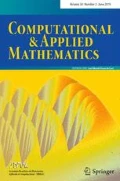Abstract
This study introduces a new family of soft separation axioms and a real-life application utilizing partial belong and natural non-belong relations. First, we initiate the concepts of w-soft \(T_i\)-spaces \((i=0, 1, 2, 3, 4)\) with respect to distinct ordinary points. These concepts generate a wider family of soft spaces compared with soft \(T_i\)-spaces, p-soft \(T_i\)-spaces and e-soft \(T_i\)-spaces. We illustrate the relationships between w-soft \(T_i\)-spaces with the help of examples and discuss some sufficient conditions of soft topological spaces to be w-soft \(T_i\)-spaces. Additionally, we point out that stable or soft regular spaces are sufficient conditions for the equivalence among the concepts of soft \(T_i\), p-soft \(T_i\) and w-soft \(T_i\). We highlight on explaining the links between w-soft \(T_i\)-spaces and their parametric topological spaces and studying the role of enriched spaces in these links. Furthermore, we prove that w-soft \(T_i\)-spaces are hereditary and topological properties, and they are preserved under finite product soft spaces. Finally, we propose an algorithm to bring out the optimal choices. This algorithm is based on dividing the whole parameters set into parameter sets and then apply a partial belong relation in the favorite soft sets. This application is supported with an interesting example to show how to implement this algorithm.

Similar content being viewed by others
References
Al-shami TM (2018a) Corrigendum to “on soft topological space via semi-open and semi-closed soft sets, kyungpook mathematical journal, 54 (2014) 221–236”. Kyungpook Math J 58(3):583–588
Al-shami TM (2018b) Corrigendum to “separation axioms on soft topological spaces, annals of fuzzy mathematics and informatics, 11 (4) (2016) 511–525”. Ann Fuzzy Math Inf 15(3):309–312
Al-shami TM (2019a) Comments on “soft mappings spaces”. Sci World J Vol 2019, Article ID 6903809:2 pages
Al-shami TM (2019b) Investigation and corrigendum to some results related to g-soft equality and gf-soft equality relations. Filomat 33(11):3375–3383
Al-shami TM, El-Shafei (2019) On supra soft topological ordered spaces. Arab J Basic Appl Sci 26(1):433–445
Al-shami TM, El-Shafei (2020) Partial belong relation on soft separation axioms and decision making problem: two birds with one stone. Soft Comput 24:5377–5387
Al-shami TM, Kočinac LDR (2019) The equivalence between the enriched and extended soft topologies. Appl Comput Math 18(2):149–162
Al-shami TM, El-Shafei ME, Abo-Elhamayel M (2019) On soft topological ordered spaces. J King Saud Univ Sci 31(4):556–566
Ali M, Khan H, Son LH, Smarandache F, Kandasamy WBV (2018) New soft sets based class of linear algebraic codes. Symmetry 10:1–10
Ali MI, Feng F, Liu X, Min WK, Shabir M (2009) On some new operations in soft set theory. Comput Math Appl 57(9):1547–1553
Aygünoǧlu A, Aygün H (2012) Some notes on soft topological spaces. Neural Comput Appl 21:113–119
Babitha KV, Suntil JJ (2010) Soft set relations and functions. Comput Math Appl 60:1840–1849
Bayramov S, Aras CG (2018) A new approach to separability and compactness in soft topological spaces. TWMS J Pure Appl Math 6(1):82–93
Caǧman N, Enginoǧlu S (2010) Soft matrix theory and its decision making. Comput Math Appl 59:3308–3314
Das S, Samanta SK (2013) Soft metric. Ann Fuzzy Math Inf 6(1):77–94
El-Shafei ME, Abo-Elhamayel M, Al-shami TM (2018a) Partial soft separation axioms and soft compact spaces. Filomat 32(13):4755–4771
El-Shafei ME, Abo-Elhamayel M, Al-shami TM (2018b) Two notes on “on soft hausdorff spaces”. Ann Fuzzy Math Inf 16(3):333–336
Feng F, Li YM, Davvaz B, Ali MI (2010) Soft sets combined with fuzzy sets and rough sets: a tentative approach. Soft Comput 14:899–911
Georgiou DN, Mergaritis AC, Petropoulos VI (2013) On soft topological spaces. Appl Math Inf Sci 5:1889–1901
Hussain S, Ahmad B (2015) Soft separation axioms in soft topological spaces. Hacettepe J Math Stat 44(3):559–568
Karaaslan F (2016) Soft classes and soft rough classes with applications in decision making. Math Probl Eng Volume 2016, Article ID 1584528:11 pages
Kharal A, Ahmad B (2011) Mappings on soft classes. New Math Nat Comput 7(3):471–481
Maji PK, Roy R, Biswas R (2002) An application of soft sets in desicion making problem. Comput Math Appl 44:1077–1083
Maji PK, Biswas R, Roy R (2003) Soft set theory. Comput Math Appl 45:555–562
Matejdes M (2017) On soft regularity. Int J Pure Appl Math 116(1):197–200
Min WK (2011) A note on soft topological spaces. Comput Math Appl 62:3524–3528
Molodtsov D (1999) Soft set theory-first results. Comput Math Appl 37:19–31
Nazmul S, Samanta SK (2013) Neighbourhood properties of soft topological spaces. Ann Fuzzy Math Inf 6(1):1–15
Shabir M, Naz M (2011) On soft topological spaces. Comput Math Appl 61:1786–1799
Singh A, Noorie NS (2017) Remarks on soft axioms. Ann Fuzzy Math Inf 14(5):503–513
Tahat MK, Sidky F, Abo-Elhamayel M (2018) Soft topological soft groups and soft rings. Soft Comput 22:7143–7156
Tantawy O, El-Sheikh SA, Hamde S (2016) Separation axioms on soft topological spaces. Ann Fuzzy Math Inf 11(4):511–525
Varol BP, Aygün H (2013) On soft hausdorff spaces. Ann Fuzzy Math Inf 5(1):15–24
Yuksel S, Dizman T, Yildizdan G, Sert U (2013) Application of soft sets to diagnose the prostate cancer risk. J Inequal Appl 2013:229
Zorlutuna I, Akdag M, Min WK, Atmaca S (2012) Remarks on soft topological spaces. Ann Fuzzy Math Inf 2:171–185
Acknowledgements
The authors are thankful to the anonymous referees for their valuable comments and suggestions.
Author information
Authors and Affiliations
Corresponding author
Ethics declarations
Funding
Not applicable.
Availability of data and materials
Not applicable.
Conflict of interest
The authors declare that they have no competing interests.
Human and animal rights statement
This article does not contain any studies with human participants performed by any of the authors.
Additional information
Communicated by Anibal Tavares de Azevedo.
Publisher's Note
Springer Nature remains neutral with regard to jurisdictional claims in published maps and institutional affiliations.
Rights and permissions
About this article
Cite this article
El-Shafei, M.E., Al-shami, T.M. Applications of partial belong and total non-belong relations on soft separation axioms and decision-making problem. Comp. Appl. Math. 39, 138 (2020). https://doi.org/10.1007/s40314-020-01161-3
Received:
Revised:
Accepted:
Published:
DOI: https://doi.org/10.1007/s40314-020-01161-3
Keywords
- Partial belong relation
- Natural non-belong relation
- w-soft \(T_i\)-space
- Enriched soft topology
- Decision-making problem



